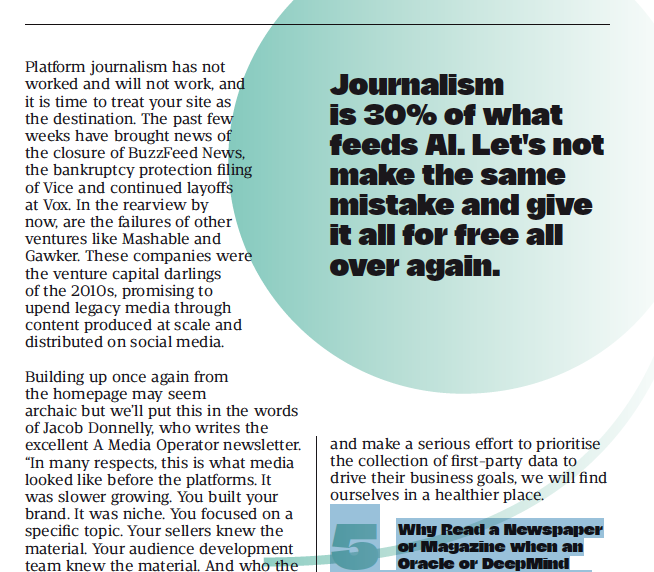
20 Jun No Content Without Consent
Editor’s Note
Change waits for no one. No sooner did we as an industry navigate the choppy waters of the Covid-19 years, than we find ourselves once again at the dawn of another era of profound technological transformation. Over the course of just a few months we have been witness to the speed at which generative artificial intelligence has burst into the public consciousness and the ways in which it might disrupt and upend traditional ways of working. We need to be sceptical
about its uses, adopt responsible frameworks for its application and perhaps then, be excited about its possibilities. But more importantly, we need to come together as an industry to ensure that we are not mere bystanders (and eventual victims) to this remaking of the digital world. Here, in short order, are the principles we need to keep in mind while navigating the turbulent times ahead.
1 No Content Without Consent — We must remember that tools like ChatGPT have been built in large part, on our hard work. Journalism is 30% of what Feeds AI. Let’s not make the same mistake and give it all for free all over again. We’ve seen this story play out before with Web 1.0 and 2.0 where we hoped that traffic driven to our websites through search migh lead us to more scale and a bright new era. In reality, Google and other search engines became dominant players in the online advertising market while publishers were left with little control over the revenue streams or their content. We cannot fall into the trap of free feeding once again, hoping we will get something
in return. As an industry we need to push for legislation to protect our intellectual property from being consumed and analysed by AI without consent and without appropriate
remuneration.
2 Find your Niche and you will Find Your Business Models — We are about to witness an explosion of online content on a scale barely imaginable. This is the time for publishers to invest more time in understanding their audiences and think deeply about the unique proposition they can offer them. Find your audience once again and you
can develop business models that have high margins, loyal membership followers, or direct relationships with specific advertisers without depending on platforms. Every year, our chapter on the best business models for publishers grows in scope and there is plenty to give you food for thought.
3 Digital-First does not Mean Social Media- First — It is time to put this concept to bed once and for all. Platform journalism has not worked and will not work, and it is time to treat your site as the destination. The past few weeks have brought news of the closure of BuzzFeed News, the bankruptcy protection filing of Vice and continued layoffs at Vox. In the rearview by now, are the failures of other ventures like Mashable and Gawker. These companies were the venture capital darlings of the 2010s, promising to upend legacy media through content produced at scale and distributed on social media.
Building up once again from the homepage may seem archaic but we’ll put this in the words of Jacob Donnelly, who writes the excellent A Media Operator newsletter. “In many respects, this is what media looked like before the platforms. It was slower growing. You built your brand. It was niche. You focused on a specific topic. Your sellers knew the
material. Your audience development team knew the material. And who the reader was mattered.”
4 The CPM (cost-perthousand) model is broken — stop trying to fix it. As AI-powered tools become more sophisticated and able to answer questions directly, the number of page impressions for news sites will shrink and this will lead to a corresponding decrease in advertising revenue. To address this issue, news organisations must explore new and innovative advertising models that are not dependent on page views. This is AI’s real threat to a display-ad dependent news model and at this juncture it’s worth thinking about just how much damage the embrace of programmatic advertising has caused the industry. Some may rue the eventual phase out of third-party cookies by Google Chrome and look for Big Tech to once again provide an alternative, but this is a bad idea whose time is over. When publishers start to embrace their direct relationships with audiences and make a serious effort to prioritise the collection of first-party data to drive their business goals, we will find ourselves in a healthier place.
5 Why Read a Newspaper or Magazine when an Oracle or DeepMind can give me the answers? This is a time, once again, to understand what makes us unique, different
and valuable. Print editions are too valuable to waste on content that users can get from elsewhere. Instead, they should be cherished and treated appropriately as the premium products that they are, curating information with the insight and depth of perspective and understanding that only humans can bring. Do this, and you will find that there will be new and exciting avenues for advertising revenue as brands look for unique value propositions. A year is a long time in today’s world and much may have changed by the time we come to you next. But as we look to the challenges and opportunities ahead, we leave you with one of our oldest maxims: be positive while remaining negative. It is the only way.
Happy reading!
The Innovation in News Media World Report is published every year by INNOVATION Media Consulting, in association with FIPP. The report is co-edited by INNOVATION President, Juan Señor, and senior consultant, Jayant Sriram


